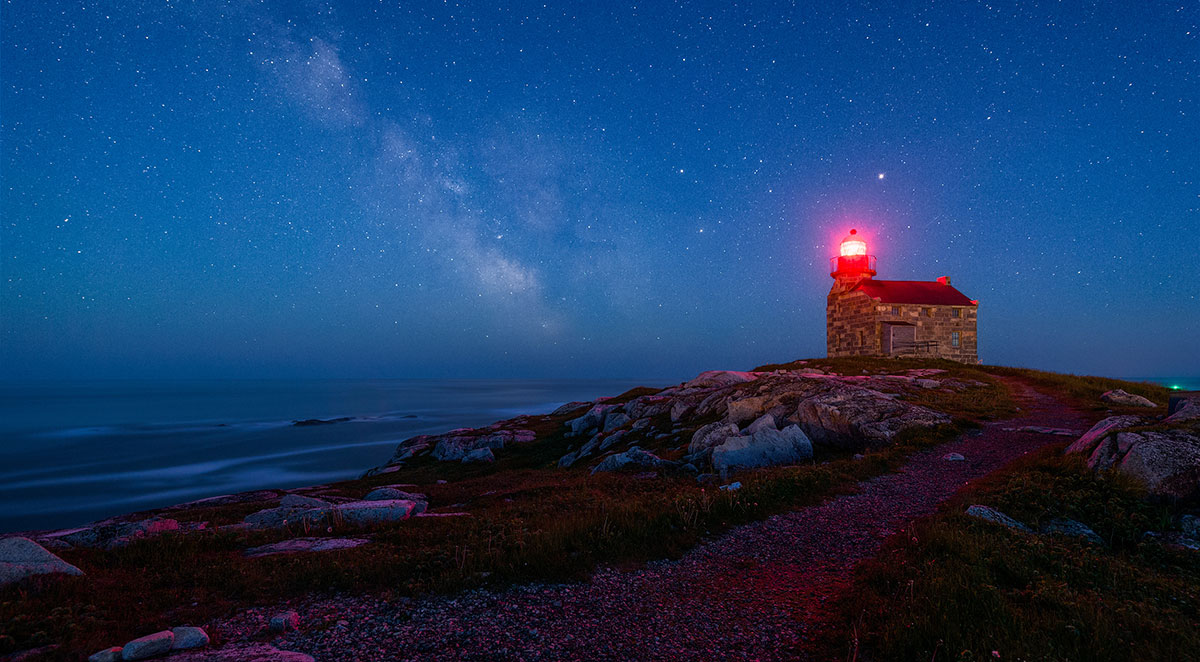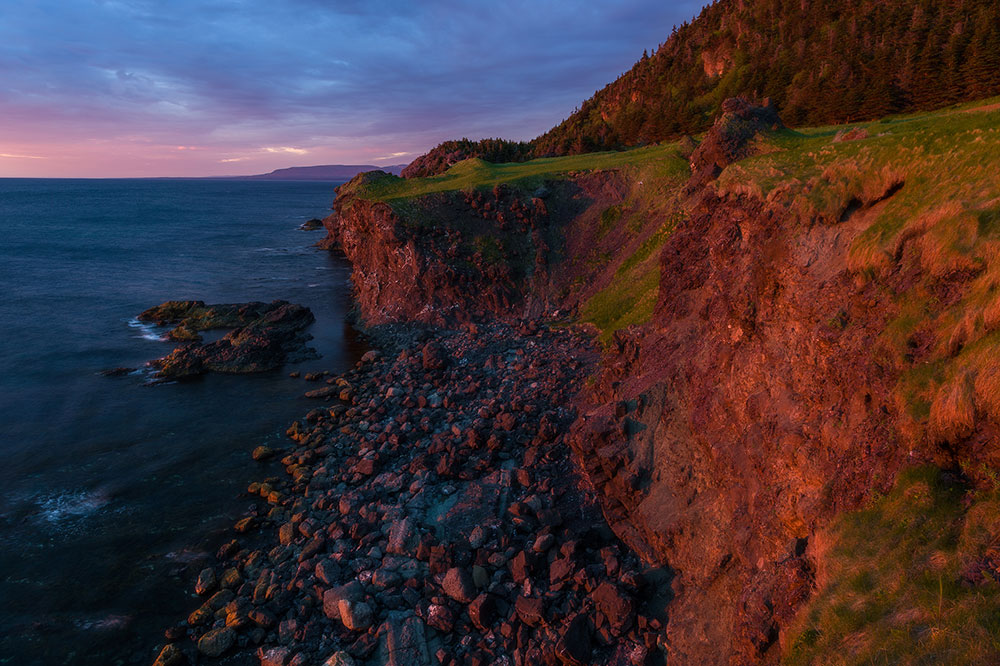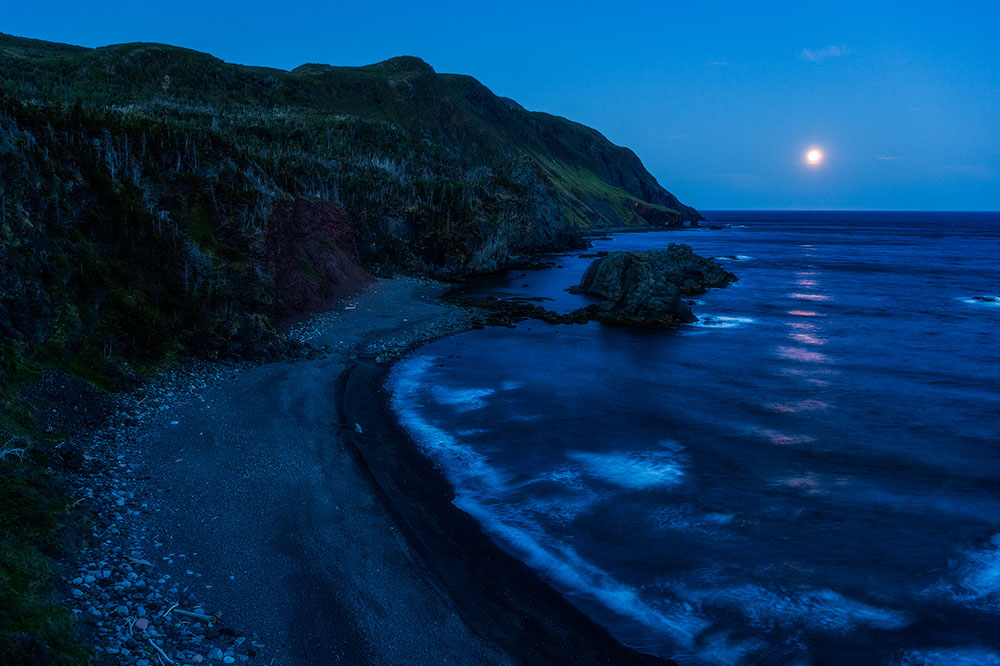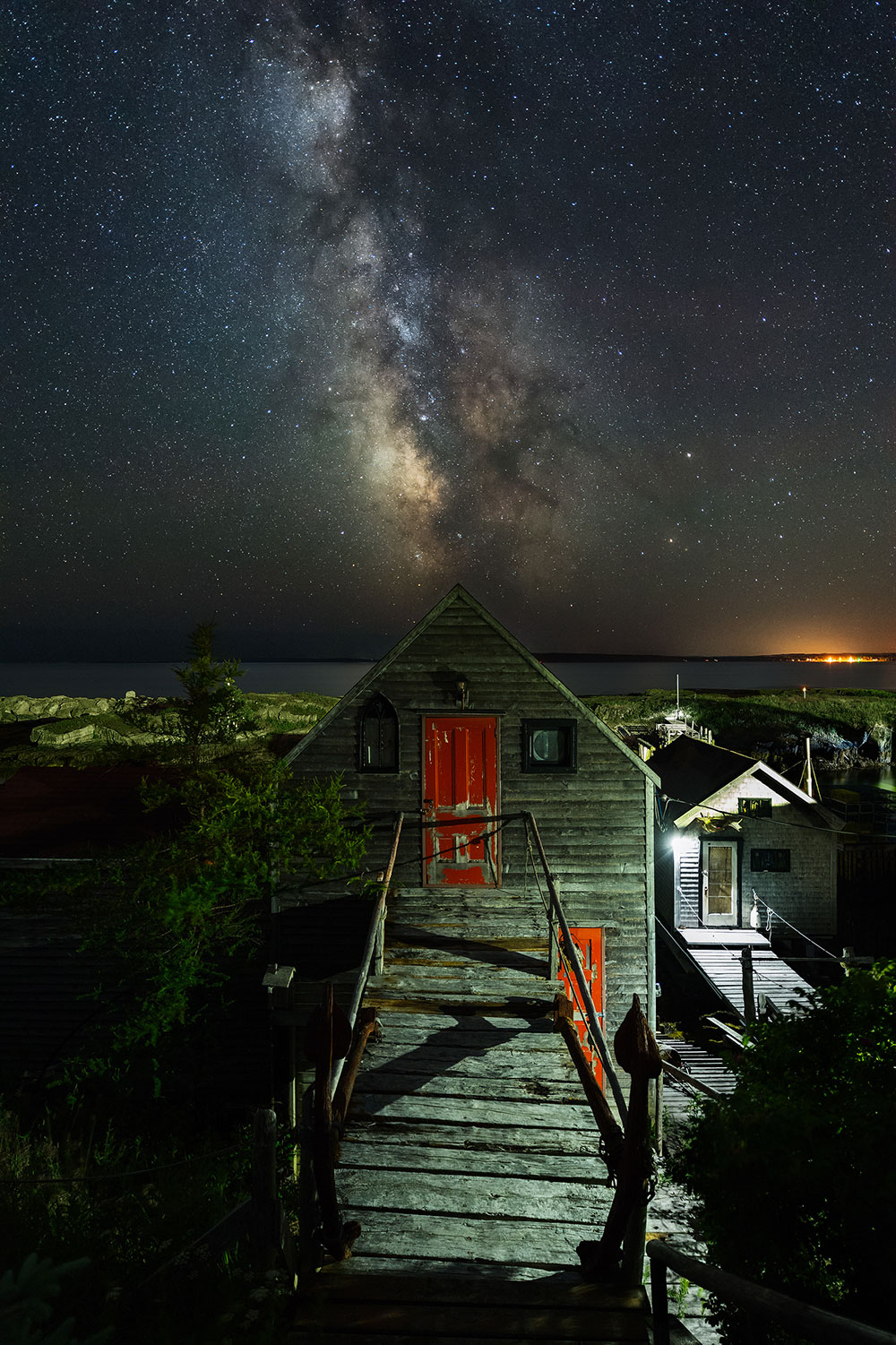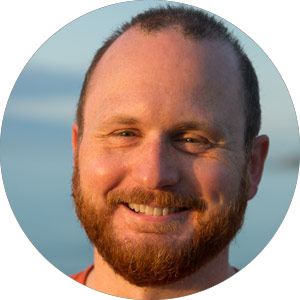Dusk to Dawn: Adam Woodworth Takes the Nikon D5 into Darkness
“Sometimes it’s more about the journey than the photo,” theorizes landscape astrophotographer Adam Woodworth. “You reach a spot then don’t get the image you want, but the experience is amazing. Other times it happens that both journey and photo leave you excited.” On a return visit to Newfoundland, this time carrying the Nikon D5, Woodworth walked away with both.
Once more photographing the night skies, Woodworth packed the Nikon D5, a camera boasting native ISO 100 to 102,400 (expandable to Hi-5 / ISO 3,280,000 equivalent), plus three lenses, a tripod, sleeping bag, food and clothing. From that favored shoot location he was interested in learning what the D5 could capture in the dark.
Sunset at Green Gardens
The afternoon of the shoot, Woodworth double-checked the time of moonset using the PhotoPills app, noting the hour when the moon would be setting next to the cliffs at Green Gardens. His journey would take him along a hiking trail that was mostly in the woods. “I started across the street from the Tablelands, a desert like place that is actually the earth’s mantle brought up to the surface and formed into flat top mountains. The hike goes through similar barren terrain below those mountains, but very soon goes into the woods after passing a small lake,” he shares.
After hiking for a couple of hours, Woodworth arrived at the seaside cliffs of Green Gardens in time to verify the angle that he wanted for shooting a moonset, plus have time to scout for other potential shots. As the sun lowered to the horizon he grew a little concerned that incoming clouds may linger overnight and possibly block the moonset. Fortunately they: “Moved in and out pretty fast. As it happens, the clouds moved far enough east by sunset to put a gap between them and the western horizon where the sun was setting, bringing an amazing light show that placed pinks on the clouds and a very warm intense light on the foreground.”
Nikon D5, AF-S NIKKOR 24-70mm f/2.8E ED VR lens at 24mm. Single exposure, ISO 100, f/11 for 0.8 seconds.
Taking advantage of the moment, Woodworth ran around the edges of the cliffs looking for compositions that best captured the light and grassy terrain. He found this angle (above) not far from where he was planning to shoot the next morning. This image was created with the D5 at ISO 100, exposing for 0.8 seconds and f/11 using the new AF-S NIKKOR 24-70mm f/2.8E ED VR lens.
The Blue Hour
After sunset, Woodworth took a few more shots during blue hour while exploring the beach below the cliffs, eventually settling in for the night within his sleeping bag. Knowing that the moon would drop aside the bluffs between 4 and 5am, he set an alarm for 3am to give himself plenty of time—just in case the moon looked like it would be setting into the clouds, or closer to the cliffs than anticipated.
Woodworth’s moonset image (below) was created by a single exposure at ISO 400 and f/5.6 for two seconds with the AF-S NIKKOR 24-70mm f/2.8E ED VR attached and adjusted to 32mm. “I had at least an hour before the moon would hit the horizon. I knew that its warm glow as it hit the water wouldn’t last the entire time, and that the moon’s elevation next to the cliffs would look pleasing for even less time, so I worked quickly to get a couple different compositions at different focal lengths.” Woodworth shot at varying shutter speeds between 0.5 seconds and four seconds to see what the water motion looked like. “I ultimately settled on two seconds to have a dreamy sort of water look, but not so smooth that the wave action was lost. This image has a lot of retouching for creative effect to bring out the detail in the cliffs and make the scene have a dreamy feel to it, as I felt when I was standing there.”
Nikon D5 and AF-S NIKKOR 24-70mm f/2.8E ED VR at 32mm. Single exposure, ISO 400, f/5.6, for 2 seconds. Edited in Adobe Lightroom and Photoshop.
A few notes about capturing a low-light image in a single exposure: “Using one exposure is more based on the technical situation of the shot.” He elaborates, “In this situation the foreground and background were far enough apart such that a single file had everything in focus. In other cases it might need exposure stacking, exposing for the bright sky, and then another shot for the dark foreground. Here, the moonlight offered enough ambient light to get detail in the foreground without blowing out the sky in one shot.”
Two Exposures Give Pinpoint Stars
Working from another venue, Woodworth captured Rose Blanche Lighthouse on the coast of Newfoundland. Originally built from granite in 1871, the current building was extensively renovated in 1999. “I learned that Rose Blanche was originally a French settlement called Roche Blanc, or ‘white rocks.’ The name is a corruption of the phrase and likely influenced by the presence of quartz veins in some of the rocks visible from the ocean,” he shares.
Nikon D5, AF-S NIKKOR 14-24mm f/2.8G ED at 14mm. One shot for the sky at ISO 12,800, 10 seconds, f/2.8. One shot for the foreground at ISO 1600, 180 seconds, f/4.
Star shots are often taken in the 20 to 30 second range to get enough light to reduce noise, but at the cost of having small star trails. To get pinpoint stars with low noise, Woodworth normally captures 10 shots of the sky at 10 seconds (or whatever shutter speed produces pinpoint stars for the focal length), and one or more shots of the foreground at a lower ISO (often ISO 1600) at much longer shutter speeds and at different focus distances to obtain shots that will be in focus from the foreground to the stars. He then stacks the sky shots using Starry Landscape Stacker for the Mac, and stacks that result with the foreground exposures in Photoshop.
On this trek the photographer made an edict to vary exposure and ISO. “I wanted to capture pinpoint star images from short exposure times, then observe how much noise was produced by this newer camera with its larger pixels.” For “Twilight Milky Way at Rose Blanche Lighthouse” (above) he fashioned one shot for the sky at ISO 12,800 for 10 seconds at f/2.8, and one shot for the foreground at ISO 1600 for 180 seconds, f/4 using the AF-S NIKKOR 14-24mm f/2.8G ED. In-camera long exposure noise reduction was always enabled except for test shots.
“While I normally do star stacking, I didn’t do it for this assignment because I wanted to see how the D5 performed with a single sky shot,” he explains. “Image files from the D5, when shooting at higher ISOs, yielded almost non-existent magenta color noise in corners and shadowy areas of dark exposures.” As a note though, because Woodworth wasn’t using star stacking, more aggressive noise reduction was needed in post to clean up the sky exposure.
Adam Woodworth using his Nikon D5 for Astrophotography work.
The Nikon D5: a Heavenly Time Saver
“When working with image components—either the single shot for sky or the stacked star shot—all can be easily blended in post with the separate foreground shot for maximum impact,” he says. “You will still get much better results with star stacking, and I will personally continue to use star stacking, but others may be happy with a single exposure for the sky. That single exposure method requires less time in the field, and in many cases, minimal time in post to add some noise reduction.” Woodworth states that with the high ISO performance of the D5, and its greater light collection, it did not take an incredible amount of effort to clean up the image. “Star stacking isn’t a replacement for a single exposure for the scene—just for the sky exposure.”
He discovered another time saver that may be useful for some: a balanced night photograph generally requires several image files (foreground, background, sky, etc.). Woodworth feels there may be instances where the Nikon D5 camera’s ability to produce a clean exposure in a 10-second pass may reduce the overall shooting time, especially when using single exposures for the sky (add time for Long Exposure Noise Reduction processing).
And for scenarios where the night subject matter is fleeting, such as the Milky Way, a camera that makes the most of time is a boon. “Depending on the time of year, you have anywhere from maybe one to three hours of Milky Way darkness, but the angle of the Milky Way for your particular shot might be good for only a few minutes.” Working with a camera that’s capable of producing a cleaner file in a shorter exposure duration during night conditions can ease overall workflow. “While I often use star stacking, occasionally those 100 seconds for 10 exposures times 10 seconds each feels like forever as you’re chasing the tide height from being too high or too low before you have to move, so the ability to have very usable 10 second exposures in the dark is handy.”
Nikon D5, AF-S NIKKOR 14-24mm f/2.8G ED lens at 19mm. One shot for the sky at f/2.8, ISO 12,800, 10 seconds. Two shots for the foreground at different focus distances and then stacked for depth of field, each shot at ISO 1600, f/2.8, 4 minutes. As usual, I prepared the RAW files in Lightroom, stacked & blended them all in Photoshop, and continued with creative edits in Photoshop.
Art and Adventure at Night
While the Nikon D5 wasn’t designed especially for astrophotography (the Nikon D810A camera is specifically designed for astrophotography), this camera’s high ISO performance allows it to perform very well in extremely low-light scenarios. The D5 has 20.8 megapixels resolution. When compared to the Nikon D810A, which has 36.3 megapixels resolution, the Nikon D810A generates a file that has more flexibility, and should be a first choice if you are interested in only doing astrophotography. If, however, you have a more varied shooting style and are curious about how the Nikon D5 will perform for night shooting, rest assured it delivers a well-rounded performance.
Undertake your own adventurous trek and begin creating astrophotography art. With a camera such as the Nikon D5, photographers can create dreamy images—whether star stacking multiple files or capturing that single evenly-exposed view of the world.

